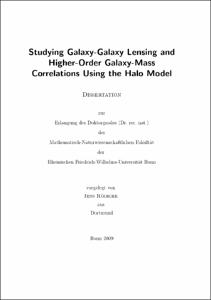Rödiger, Jens: Studying Galaxy-Galaxy Lensing and Higher-Order Galaxy-Mass Correlations Using the Halo Model. - Bonn, 2009. - Dissertation, Rheinische Friedrich-Wilhelms-Universität Bonn.
Online-Ausgabe in bonndoc: https://nbn-resolving.org/urn:nbn:de:hbz:5N-17905
Online-Ausgabe in bonndoc: https://nbn-resolving.org/urn:nbn:de:hbz:5N-17905
@phdthesis{handle:20.500.11811/4086,
urn: https://nbn-resolving.org/urn:nbn:de:hbz:5N-17905,
author = {{Jens Rödiger}},
title = {Studying Galaxy-Galaxy Lensing and Higher-Order Galaxy-Mass Correlations Using the Halo Model},
school = {Rheinische Friedrich-Wilhelms-Universität Bonn},
year = 2009,
month = jun,
note = {In recent years, the distribution of galaxies in the Universe could be measured up to large distances and over a significant part of the sky. The analysis of this large-scale structure contains a wealth of cosmological information. A particular valuable cosmological tool to probe the environment of galaxies is the galaxy-galaxy lensing (GGL) effect. It describes the distortion pattern of the images of background galaxies induced by weak gravitational lensing by individual foreground galaxies. A statistical analysis of a large number of foreground-background pairs can put tight constraints on the radial distribution of dark matter around the foreground galaxies and on the bias between galaxy and dark matter clustering. To make theoretical predictions for this cosmological probe one needs to employ a reliable model for the nonlinear gravitational clustering. In this work we use an analytical model, the so-called halo model, which combines the results of the halo mass function, the halo density profile and the clustering of halos obtained from numerical N-body simulations and from theoretical models. To include galaxies into the halo model, we adopt the so-called halo occupation distribution (HOD), which consists of the conditional probability that a halo of a given mass contains a number of galaxies and the distribution of galaxies around the halo center.
In a first project we study an extension of GGL to third-order galaxy-mass correlations which are sensitive to the weak lensing distortion pattern around pairs of galaxies. The new cosmological probe was termed galaxy-galaxy-galaxy lensing (GGGL) and recently measured in the RCS fields. Instead of providing theoretical predictions of these third-order correlation functions, we analyze their corresponding third-order aperture statistics which allow for a clean separation of the cosmological signal (E-mode) and systematic effects (B-modes). In this work we analyze their dependence on HOD parameters. In general, we find that the variation of the considered parameters have a stronger effect on the galaxy-galaxy-mass than on the mass-mass-galaxy correlations. These distinct features of the two cross-aperture statistics can be used in future GGGL experiments to constrain different galaxy formation models, which is one of the key goals of modern cosmology.
In a second project, we study for the first time the effect of non-Gaussian errors on the measurements of GGL power spectra which emerge from the nonlinear gravitational clustering of dark matter and galaxies. We show that on large scales the errors follow approximately a Gaussian distribution, whereas on small scales significant cross-correlation between different band powers are induced. The importance of non-Gaussian effects are reduced when we include shot- and shape-noise contributions. These results are essential to make realistic forecasts of the ability of future GGL surveys to constrain cosmological parameters.},
url = {https://hdl.handle.net/20.500.11811/4086}
}
urn: https://nbn-resolving.org/urn:nbn:de:hbz:5N-17905,
author = {{Jens Rödiger}},
title = {Studying Galaxy-Galaxy Lensing and Higher-Order Galaxy-Mass Correlations Using the Halo Model},
school = {Rheinische Friedrich-Wilhelms-Universität Bonn},
year = 2009,
month = jun,
note = {In recent years, the distribution of galaxies in the Universe could be measured up to large distances and over a significant part of the sky. The analysis of this large-scale structure contains a wealth of cosmological information. A particular valuable cosmological tool to probe the environment of galaxies is the galaxy-galaxy lensing (GGL) effect. It describes the distortion pattern of the images of background galaxies induced by weak gravitational lensing by individual foreground galaxies. A statistical analysis of a large number of foreground-background pairs can put tight constraints on the radial distribution of dark matter around the foreground galaxies and on the bias between galaxy and dark matter clustering. To make theoretical predictions for this cosmological probe one needs to employ a reliable model for the nonlinear gravitational clustering. In this work we use an analytical model, the so-called halo model, which combines the results of the halo mass function, the halo density profile and the clustering of halos obtained from numerical N-body simulations and from theoretical models. To include galaxies into the halo model, we adopt the so-called halo occupation distribution (HOD), which consists of the conditional probability that a halo of a given mass contains a number of galaxies and the distribution of galaxies around the halo center.
In a first project we study an extension of GGL to third-order galaxy-mass correlations which are sensitive to the weak lensing distortion pattern around pairs of galaxies. The new cosmological probe was termed galaxy-galaxy-galaxy lensing (GGGL) and recently measured in the RCS fields. Instead of providing theoretical predictions of these third-order correlation functions, we analyze their corresponding third-order aperture statistics which allow for a clean separation of the cosmological signal (E-mode) and systematic effects (B-modes). In this work we analyze their dependence on HOD parameters. In general, we find that the variation of the considered parameters have a stronger effect on the galaxy-galaxy-mass than on the mass-mass-galaxy correlations. These distinct features of the two cross-aperture statistics can be used in future GGGL experiments to constrain different galaxy formation models, which is one of the key goals of modern cosmology.
In a second project, we study for the first time the effect of non-Gaussian errors on the measurements of GGL power spectra which emerge from the nonlinear gravitational clustering of dark matter and galaxies. We show that on large scales the errors follow approximately a Gaussian distribution, whereas on small scales significant cross-correlation between different band powers are induced. The importance of non-Gaussian effects are reduced when we include shot- and shape-noise contributions. These results are essential to make realistic forecasts of the ability of future GGL surveys to constrain cosmological parameters.},
url = {https://hdl.handle.net/20.500.11811/4086}
}






